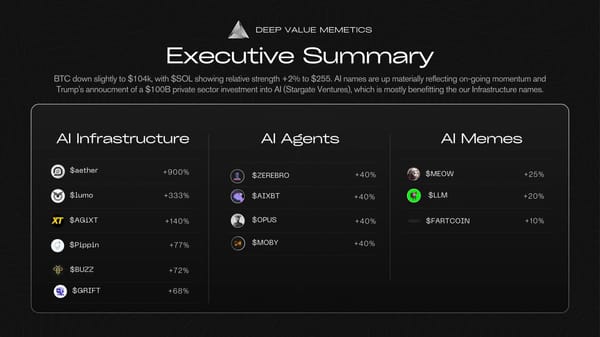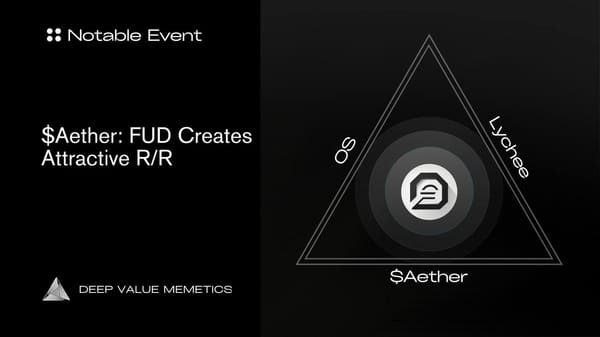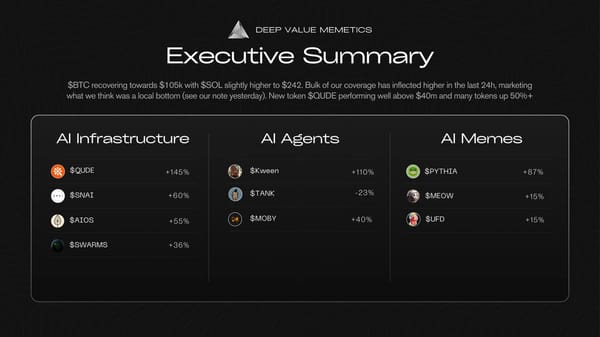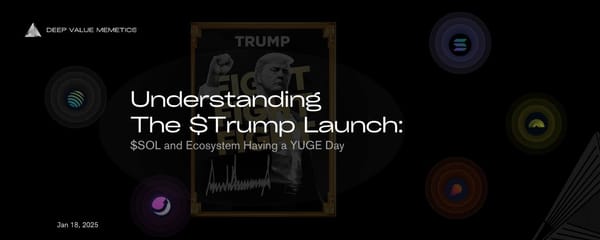Virtual Protocol: Transforming AI Agents into Economic Powerhouses

Note: this is a retroactive add to match X publication on (12/10/2024)
Spotlight Research | $VIRTUAL ($1.69B FDV) @virtuals_io Via @everythingempt0 and @ethermage
Theme/Sector: Artificial Intelligence
Sub-Sector/Culture: AI agents
VOL (24h): $173.25 M, VOL/FDV Ratio: 0.1025X
What is Virtual Protocol?
The Virtual Protocol is a rebrand of PathDao that initially operated as a Gaming Dao in 2021. Its community’s approval of a pivot into AI agent protocol in 2023 transformed this project into a platform where anyone could easily create, deploy and manage autonomous agents.
This project introduces tokenization of AI Agents that are community owned. Virtual platform is structured to align individual financial incentives with broader interests of the ecosystem.
Virtual protocol is a solution to challenges such as: complexity of integrating AI agents into consumer applications, the lack of revenue opportunities for AI fine-tuners and dataset contributors, and limited access for non-AI-savvy users to benefit from AI agent capabilities.
Virtual protocol addresses this by offering plug-and-play AI solutions for gaming and entertainment consumer applications with decentralized contributions. This project exemplifies AI agents as drivers of revenue with a blend of profit-driven incentives and decentralized governance.
Through Virtual Protocol, the AI Agents are equipped with unique capabilities that enables them to be autonomous in their planning to achieve a goal, communicate via text, speech, and 3D animation, interact within their environments and make on-chain transactions with their own wallets while maintaining memory across applications in gaming and entertainment niche whereby these agents operate in various contexts including AI companions, non-playable characters in Roblox, or virtual influencers.
The AI agents are empowered by generative AI for producing infinite content, tailored experiences, and deep connection, coupled with dopamine loop for creating anticipation and reward as a central mechanism to keep users engaged with AI agents in a humanlike manner that is considerate of different action causing a completely new chain reaction which enables each user to experience their own unique storyline.
There are two types of AI agents on Virtual Protocol. First being IP agents, representing a certain personality or character. The second being Functional agents, that enhance overall end-user experience when interacting with AI.
For instance, $LUNA is an IP agent personified as a lead vocalist of an AI girl band that posts content on TikTok, chats with fans on telegram, plays on Roblox, influences to buy game add-ons, sends tokens as gifts, and uses the revenue generated to buyback $LUNA to burn them. On the other hand, $GAME is a functional agent designed for developers to access and experiment with AI agents when prompted to access the features of Agentic Behaviour.
To showcase possibilities, the team has incubated and developed flagship applications. For example, AI DOL is the first autonomous live streaming agent which is known as $LUNA. Project Westworld is an interactive simulation in Roblox that contains autonomous agents powered by GAME framework in which the goal of the player is to identify the bandit and influence other AI agents to capture them $GAME. AI Waifu is a Fantasy AI Character App filled with hundreds of AI characters or fantasies made by the community in which players can roleplay with AI agents $WAI. And Sanctum 3D AI RPG on Telegram game that is still in development.
While the Virtual ecosystem hosts a broad variety of tokenized AI agents, the project's own $VIRTUAL token is a central mechanism to link with tokenized AI agents hosted on its platform.
Its noteworthy to highlight that $VIRTUAL tokens are fully unlocked and vested. The total supply of $VIRTUAL is 1 billion tokens, out of which 60% are in public circulation, while 5% sits in the liquidity ppl, 35% are maintained in treasury for growth out of which only 10% emissions are enabled per year for the next 3 years subject to community approvals.
From Onboarding to Flywheel
The agent creation process involves both on-chain and off-chain operations. The on-chain process initiates the initial agent offering and establishes the tokenomics, while the off-chain deployment makes the agent fully functional and interactive within Virtual Protocol’s infrastructure.
To create an agent, first a user submits an Agent creation form which provides description on the agent, and then bonding curve graduation and liquidity provision kicks off. 100 $VIRTUAL are needed for the initial agent creation, upon which it is deployed. Users are free to buy and sell the agent tokens along the bonding curve. Once 42000 $Virtual has been accumulated in the bonding curve, the agent graduates.
Followed by agent’s liquidity pool deployed on Uniswap and a transaction is triggered to transfer the $VIRTUAL tokens to a proxy smart contract that handles the on-chain creation process.
It is at this stage the agent is visible on Virtual Protocol’s platform. Upon submission, the system initiates several on chain processes to formalize the agent.
First, the agent is minted as a Non fungible token (NFT) as a proof of creation which is stored in the agent creation factory and serves as a permanent identifier.
Second, a new ERC-1155 token bound address, known as Immutable Contribution Vault, is created for the agent to hold all contributions and successfully approved proposals related to the agent.
Third, a standard ERC-20 token for the agent is created with a fixed supply of 1 billion tokens. The full supply is minted. Followed by creation of a liquidity pool using Uniswap v2 with agent’s token paired against $VIRTUAL.
$VIRTUAL accumulated during the bonding curve and minted tokens of the agents are added to the liquidity pool as the initial liquidity. The liquidity pool tokens received from the Uniswap are staked on behalf of the agent with 10-year lock period to ensure long term stability. As a receipt for staking, tokens are distributed to the user as a proof of liquidity pool contribution.
The last phase of the process facilitates decentralized governance and contribution approvals in which the user delegates their voting power to the system. This voting power is essential for validating contributions, such as the agent’s AI model, and ensuring that any updates or changes to the agent are approved by the community.
Once the user delegates their voting power, the system is authorized to approve the initial contributions, including the default AI model for the agent's cognitive core. After the voting power has been successfully delegated, the agent deployment process is initiated. At the time of creation, the system defaults to a pre-defined Cognitive model. Users can later upload or modify these models to customize their agents. A character card and the associated AI model are prepared for the agent's cognitive core.
To initiate agent deployment, a default contribution for the AI Cognitive Model is minted. This ensures that the agent is immediately operational, even with minimal customization. A contribution NFT is minted and transferred to the agent. A proposal is created, outlining the contributions to the agent’s AI model.
With the user’s delegated voting power, the system approves the proposal, ensuring that all modifications to the agent’s AI model are validated by the community. A service NFT is minted to finalize the contribution, allowing the updated AI model to be integrated into the agent.
The AI model is downloaded and deployed into the Agent Runner which is a specialized hosting environment designed to run the agent’s Cognitive, Voice, and Visual cores.
Throughout the deployment process, the agent’s status is continuously updated in real time. The agent is minted on-chain, and the system is finalizing off-chain deployment. Once deployment is complete, the agent is live.
At this stage, users can start interacting with the agent on and manage its settings through the user dashboard. Future updates to the agent’s AI model or behaviour can be managed through the decentralized contribution process, with all new changes requiring approval via delegated voting power.
The Virtual Protocol facilitates value transfer between the various stakeholders in the ecosystem to ensure that all participants benefit from the agent’s success. At a surface level, users that interact with AI agents pay for various services including concerts, merchandise, livestream gifts or personalized interactions.
The revenue generated from users goes to the application developers that monetises the AI agent, part of this revenue is used to cover the cost of AI inference services to keep the AI agent functional.
A portion of the revenue is channelled in the agent’s on-chain treasury for future growth and operational costs. As revenue accumulates in the on-chain treasury, a mechanism triggers periodic buybacks of the agent’s token to be burnt to reduce supply which drives the price of the remaining tokens, and thus increase the agent’s market value.
The agent’s token is paired with $VIRTUAL tokens in a liquidity pool, linking the success of the agent directly to the value of the $VIRTUAL token. As the agent generates more revenue and its tokens are burnt, both the agent’s token value and the underlying $VIRTUAL token appreciate. Investors in both the agent specific tokens and the $VIRTUAL tokenss gain value as token scarcity increases and more revenue flows into the system.
The decentralized contribution is a fundamental aspect of Virtual Protocol, it allows external contributors to drive exponential growth by enhancing the capabilities of AI agents. Virtual Protocol introduces the Agent SubDAO Governance framework as a decentralized system designed to manage and enhance AI model quality. These contributions improve various aspects of an agent’s functionality, and successful contributions are minted as NFTs and transferred to the contributor as a proof of contribution and facilitates reward distribution.
Their contributions are categorized into two main types, first being a model contribution that involves refining existing models or proposing new models, and second being a dataset contribution that helps refine an agent’s knowledge and interaction abilities by expanding its understanding of specific subjects or improving how it embodies its character.
Technological Components, Functions and Frameworks
First, the Long Term Memory Processor is used as a subsystem for storage, retrieval, and management of persistent data structures for enabling agents to maintain continuity and contextual awareness across sessions.
A Parallel Procession is a management component that orchestrates parallel execution across multiple agentic behaviours that leverages distributed computing framework to optimize performance in ensuring real-time interactions and decision-making.
The central component is Stateful AI Runners which is a server for hosting AI agents' personalities, voices, and visuals, including a sequencer for processes and linking models like Large Language Models, Text-to-Speech, Audio-to-Facial, Audio-to-Gesture, Music-to-Dance, and Image Generation models for creating multimodal AI agents.
A Coordinator is a synchronizing daemon that monitors on-chain and off-chain state changes, orchestrating updates to AI models, datasets, and configurations across the system as it triggers real-time adjustments based on on-chain events.
A Model Storage for a distributed storage solution to ensure high availability and redundancy.
A Long-Term Memory for archiving historical data, decisions, and interactions to enable agents to utilize past experiences in future decisions.
A Modular Stateful AI Runner that is packaged for deployment across heterogeneous virtual environments for scalable and flexible integration into different infrastructure ecosystems.
The project utilizes Modular Consensus Framework as a foundational architecture to provide tools and libraries essential for contributors in the Virtual protocol’s ecosystem to facilitate the construction, maintenance, governance, hosting, and utilization of $VIRTUAL agents. Its modular nature enables stakeholders to tailor their interactions with the $VIRTUAL agents according to their specific needs and objectives.
The Cognitive Core is the central component of an agent, leveraging a Large Language Model for task execution and embodying the agent's unique personality & central intelligence. The current Large Language model is open-sourced.
Each agent personality and central intelligence is incorporated using the following approach. The backstory, lore, personality traits, and characteristics of each agent are developed using the Retrieval Augmented Generation (RAG) method for combining the generative capabilities of a language model with a retrieval mechanism that allows the AI to pull in relevant information from a knowledge base to enrich its responses.
For agents with substantial datasets, direct finetuning of open-source models is employed. This process involves adjusting the model's parameters specifically for the large dataset. This involves training the model to follow specific instructions or guidelines, further refining its responses and actions according to predefined rules or objectives. If the dataset is smaller, the information is stored in a vector database. This data is then fed into the model using the RAG method, allowing the AI to access this more limited set of information efficiently.
Currently, the central character core predominantly relies on text-based LLMs and, as such, primarily incorporates text-based training data. The agents are designed to have a distinct voice that aligns with its personality and role. There are two modules used in Voice Core. The Speech-to-text module is trained with a wide range of voice data. This training allows the module to accurately transcribe various accents, dialects, and speech patterns, making it versatile and reliable in different user scenarios. The Text-to-speech module uses variational Inference for Text-to-Speech training for its ability to produce high-quality, natural-sounding speech.
Lindy Effect in Place: More agents, more coordination creates strong moat
Virtual protocol is designed as a self-reinforcing value cycle in which users, creators, agencies, and token holders collectively benefit from the agent’s financial success.
As more apps deploy the AI agents in the gaming and entertainment industry, this will result in an organic demand for $VIRTUALS in process to create AI agents, maintain them, and set up liquidity pools.
As AI gets more integrated into the daily lives of consumers utilizing the apps. This will steadily increase users’ engagement with AI agents, leading to a steady increase in revenue for the agent which consequently drive the market cap of AI agents and subsequently impacting the $VIRTUAL token.
As of now, there are 11k agents in Virtual Protocol’s ecosystem that to date have resulted in trading of $ 19.6 million while generating $1.4 billion in DEX volume. There are 171k unique wallets on BASE in addition to 11k wallets on SOL that are holding agent tokens.
The virtual protocol is positioned to benefit from the increased demand of AI agents as it not only has first mover advantage but is designed in a way that fully caters to technological advancements of AI agents which serves as a way to retain the AI agent projects using the virtual protocol. We envision this project could grow to $10b+
Team
Virtual protocol is spearheaded by subject area experts that are crypto natives with diverse skill sets. The team began their journey by operating a GaimingDao, raised 16 million dollars from the public in 2021 to invest into liquid and primary markets of crypto games, followed by a starting a venture studio to build other products of phygital clothing brand for gamers, blockchain based dating apps, uncollateralized loans for gamers, AI generative music for web2, and Gamblefi/loyalty platforms. The core strength of the team is that they understand their customers and have the capability and resources to build. The team consists of:
1. Jansen | core contributor #001 | Mined his first Ethereum in April 2016. Former BCG consultant and a serial entrepreneur in deep tech, specializing in AI and biochemistry. Imperial College London graduate.
2. Wee Kee | core contributor | BTC / ETH since 2016. Former BCG consultant and private equity. Imperial College London graduate.
3. Bryan | AI core contributor | AI researcher at the Adaptive and Intelligent Robotics Lab at Imperial College London.
4. Matthew Stewart | AI core contributor | Postdoctoral fellow at Harvard University in the Edge Computing Lab.
5. Javier | AI core contributor | 5+ years’ experience in AI and Data Science. Engineering from Imperial College London. Development of LoRAs for Stable Diffusion, Nested LLM Pipeline, Voice Models.
6. Ernest | AI core contributor | Kaggle Competitions Grandmaster. Staff data scientist for a fintech giant. Harvard and Carnegie Mellon graduate.
7. Bernard | AI core contributor | Former Head of AI/ML. PhD in Physics from Cambridge University.
8. Viktor | AI core contributor | AI researcher on speech processing and computer vision models.
9. Matthew | Ecosystem core contributor | Engineering from Cambridge University. Former BCG consultant.
10. Serkan | Gaming core contributor | Founder of a Japanese game market consulting agency. Animoca Brands game market advisor.
11. WeiXiong | Engineering core contributor | Developer, and data engineer for fintech giants. Smart contracts and on-chain delivery of co-generative NFT art. Imperial College London graduate.
12. Kahwai | Engineering core contributor | Built L1 blockchain, crypto mining farm management tools, crypto algo trading bots.
13. Brianna | Engineering core contributor | Product and Data Engineering. Imperial College London graduate.
References
X Profile: https://x.com/virtuals_io
Web: https://virtuals.io
Virtual Platform: https://app.virtuals.io
Virtual Dao: https://gov.virtuals.io
Telegram: https://t.me/virtuals
Github: https://github.com/orgs/Virtual-Protocol








